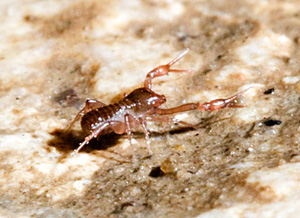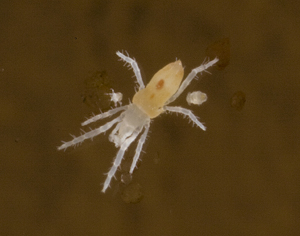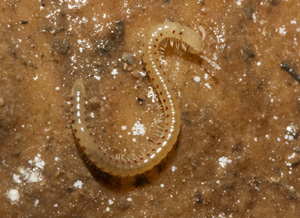 |
Cave Life of Mendip |
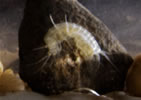 |
| |
| HOME |
| INTRODUCTION |
| LIFE IN THE ENTRANCE |
| LIFE IN THE CAVE |
| CONSERVATION |
| GLOSSARY |
| ACKNOWLEDGEMENTS |
| Bacteria |
| Fungi |
| Plants, Algae & Protozoans |
| Flatworms |
| Eelworms & Segmented Worms |
| Slugs & Snails |
| Crustacea |
| Insects |
| Spiders & Millipedes |
| Fish & Amphibians |
| Birds |
| Bats |
| Fossils and archeology |
| |
Spiders and millipedes |
||||||||||||||
Meta menardi is a large, dark brown, orbweb spinning troglophilic cave spider that is well known to cavers. Meta spiders need space to create these webs, but they are not spun across the cave passage like normal orb spiders unless there is nothing else to anchor the web to. The threads of the web of Meta menardi are not sticky and appear to serve as a supportive platform for the spider rather than directly serving to trap prey, instead the radial threads act as a series of trip lines to detect the presence of potential prey on the cave walls and ceiling. They feed on woodlice, millipedes, slugs, earthworms, flies (Culex pipiens in particular) and possibly smaller Meta menardi (although there is no evidence of this). It can gorge itself and may store food by trussing it in the web.
Meta menardi prefers reflected light and dim zones (not direct light) and appears to live slightly deeper in a cave during the winter. Movements of different species towards or away from the threshold at different times of year may change the dynamics of the spider’s diet. It also appears to prefer vertical shafts, presumably because more prey might fall in. The webs are orientated away from light – at 90 degrees and are to be found in the shadows e.g. in phreatic pockets and scallops – by spinning them here they may trap fungus gnats seeking shade or maybe they are simply harder for prey to spot.
There a number of small spiders belonging to the Linyphiidae family ('money spiders') e.g. Neriene sp., Porrhomma sp. that are found in caves. Porrhomma.convexum is common and has been recorded from Blake’s Farm Cave, Sidcott Swallet, Stoke Lane Slocker and Swildon’s Hole. P. egeria has been recorded from Elm Cave and Goatchurch. Porrhomma sp. webs are often in obscure cracks and crevices in the walls of the cave, and the spiders even harder to spot. Other 'money spiders' include Lophocarenum nemorale, Lessertia dentichelis, Erigone dentipalpis, Centromerus prudens and three species of Lepthyphantes: L. pallidus, L. zimmermanni and L. ericaeus.
Three species of Harvestmen (Opiliones) have been recorded from the threshold of several Mendip Caves, including Phalangium opilio, Liobunum blackwalli and Nemastoma chrysomelas. These are all accidentals, their true habitat being the matted grasses and loose soils around the entrances. Unlike spiders, harvestmen have no venom, they also only have one pair of eyes so their vision is not as good. They have no silk glands and do not spin webs. Pseudoscorpions are small and abundant arthropods but are difficult to spot as they are only 2-4mm in length. They are aggressive hunters and use their enlarged pedipalps to catch prey. Once it has sucked up the contents of its prey it can survive for weeks even months without another meal. They may have small territories - this one was found in exactly the same place 2 weeks later.
Rhagidia mites run about quickly with no apparent purpose except possibly to hide from your light.
Millipedes are more common with a number of cavernicole species, some of which are blind. Millipedes feed on plant debris including wood and are particularly common in oak woodlands on limestone, living for several years. Cave forms often have a thinner shell and more sensory bristles than those on the surface. The three species most frequently recorded in Mendip caves are Blaniulus guttulatus, Brachydesmus superus and Nanogona polydesmoides (formerly Polymicrodon polydesmoides), which occur in the dark zone and can be considered cavernicolous. Several other species have been recorded, including members of the families Glomeridae, Brachychaeteumidae, Polydesmidae, Blaniulidae and Iulidae.
|
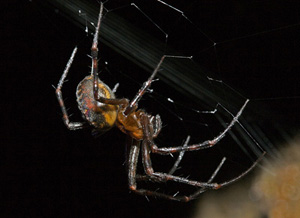
.jpg)
.jpg)
